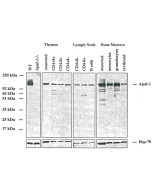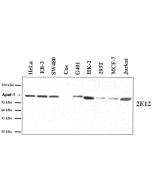Cookie Policy: This site uses cookies to improve your experience. You can find out more about our use of cookies in our Privacy Policy. By continuing to browse this site you agree to our use of cookies.
AdipoGen Life Sciences
anti-Apaf-1, mAb (18H2)

| Product Details | |
|---|---|
| Synonyms | Apoptosis Protease-activating Factor 1 |
| Product Type | Monoclonal Antibody |
| Properties | |
| Clone | 18H2 |
| Isotype | Rat IgG2aκ |
| Immunogen/Antigen | Recombinant mouse Apaf-1 (aa 1-97) containing the N-terminal CARD domain. |
| Application |
ELISA |
| Crossreactivity |
Human Mouse |
| Specificity |
Recognizes the CARD domain of human and mouse Apaf-1. Does not cross-react with rat Apaf-1. |
| Purity | ≥95% (SDS-PAGE) |
| Purity Detail | Protein G-affinity purified. |
| Endotoxin Content | <0.1EU/μg purified protein (LAL test; Lonza). |
| Concentration | 1mg/ml |
| Formulation | Liquid. In PBS containing 0.02% sodium azide. |
| Isotype Negative Control | |
| Shipping and Handling | |
| Shipping | BLUE ICE |
| Short Term Storage | +4°C |
| Long Term Storage | -20°C |
| Handling Advice |
After opening, prepare aliquots and store at -20°C. Avoid freeze/thaw cycles. |
| Use/Stability | Stable for at least 1 year after receipt when stored at -20°C. |
| Documents | |
| MSDS |
 Download PDF Download PDF |
| Product Specification Sheet | |
| Datasheet |
 Download PDF Download PDF |
Apaf-1 is a cytoplasmic protein that forms one of the central hubs in the apoptosis regulatory network. It contains (from the N terminal) a caspase recruitment domain (CARD), an ATPase domain (NB-ARC), few short helical domains and then several copies of the WD40 repeat domain. Upon binding cytochrome c and dATP, this protein forms an oligomeric apoptosome, mediates the cytochrome c-dependent autocatalytic activation of pro-caspase-9 (Apaf-3), leading to the activation of caspase-3 and apoptosis.
- Apaf-1 is a transcriptional target for E2F and p53: M.C. Moroni, et al.; Nat. Cell Biol. 3, 552 (2001)
- Apocytochrome c blocks caspase-9 activation and Bax-induced apoptosis: A.G. Martin & H.O. Fearnhead; J. Biol. Chem. 277, 50834 (2002)
- Apaf-1 and caspase-9 accelerate apoptosis, but do not determine whether factor-deprived or drug-treated cells die: P.G. Ekert, et al.; J. Cell. Biol. 165, 835 (2004)
- Is Apaf-1 expression frequently abrogated in melanoma?: J.D. Allen, et al.; Cell Death Differ. 12, 680 (2005)
- The DNA repair complex Ku70/86 modulates Apaf1 expression upon DNA damage: D. De Zio, et al.; Cell Death Differ. 18, 516 (2011)
- Apoptosome formation upon overexpression of native and truncated Apaf-1 in cell free and cell-based systems: A.R. Noori, et al.; Arch. Biochem. Biophys. 642, 46 (2018)
- The Lumiptosome, an engineered luminescent form of the apoptosome can report cell death by using the same Apaf-1 dependent pathway: E.S. Hosseini, et al.; J. Cell Sci. 133, 242636 (2020)
- Loss of WD2 subdomain of Apaf-1 forms an apoptosome structure which blocks activation of caspase-3 and caspase-9: A.R. Noori, et al.; Biochim. 180, 23 (2021)







